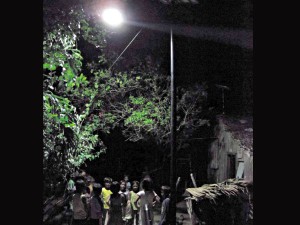
SOLAR-POWERED Children play games under a solar-powered street light in remote Polillo island in Quezon province. INQSnap this page (not just the logo) to view more photos. TEAM ENERGY FOUNDATION INC./CONTRIBUTOR
Farmer Allan Batalla, 32, recalled the humdrum life in the boondock village of Lipata in the island town of Panukulan, Quezon, two years ago.
“After sunset the day was over. There were no more things to do except go to bed and sleep. It was boring, but the whole village had been used to it since time immemorial,” Batalla told the Inquirer in a phone interview.
Panukulan and two other municipalities—Polillo and Burdeos—are on Polillo Island off Lamon Bay facing the Pacific Ocean.
In September 2011, life in Lipata, a six-kilometer hike from the town proper, suddenly changed. Electricity from solar energy came through a public-private project initiated by the Department of Energy (DOE), Quezon Electric Cooperative II and TeaM Energy (TE) Corp.
‘Heart and Soul’
Called “Heart and Soul” (Household Electrification Assistance through Renewable Technology and Social Preparation for the Upliftment of Lives), the project was funded by the government through the DOE and implemented by Team Energy Foundation Inc. (Tefi), TE’s corporate social responsibility arm.
Started in January 2010 and completed in early 2013, it would help the government attain 90-percent village electrification across the country by 2017, said the project proponents.
Batalla said most of the villagers immediately bought cell phones after the installation of solar home systems in their place as there were signals from two giant telecommunication networks.
He said his two daughters who were enrolled in an elementary school, began getting good grades because they could study at night since a solar-powered bulb lighted their hut. The family used to spend P15 a day to buy kerosene for their “gasera” (kerosene lamp) so they could have light at night, but strong winds would easily put out the flame.
“Now, they can study all night long,” said Batalla, who is also president of the Renewable Energy Community Development Association (Recda) composed of 156 member-households.
Membership fee
Every member pays P800 membership fee that entitles them to acquire one unit of the solar home system costing P15,000.
In a statement sent to the Inquirer, Roderick de Castro, Tefi executive director, said Recda was organized to sustain the electrification program anchored on a multisectoral and community-driven approach.
Lipata also has two solar-powered street lights, Batalla said. One unit costs P80,000.
“The children can now play games even at night while their elders enjoy their own parties which used to be conducted in daytime,” Batalla said.
The electrification project entailed responsibility for the beneficiaries. They must pay P332 monthly fee to help defray costs for future maintenance of their solar home systems. Nonpayment after a 100-day grace period resulted in confiscation of the system from seven members of the association.
Economy spark
“Through our electrification program, along with livelihood training and capacity-building initiatives, we wish to spark local economic activity and improve socioeconomic conditions in these areas,” said Greggy Romualdez, head of TE external affairs.
The majority of the people in Burdeos, Patnanungan and Panukulan are poor farmers and fisherfolk who have been organized and trained to maintain and repair the stand-alone solar home panels. The solar home system is for only one house and the wire does not extend to neighbors.
“While many of us take electricity for granted, we must realize that there are still areas in our country that do not have access to this very basic necessity,” Romualdez said.
The off-grid electrification project of Tefi also covered two more villages in Panukulan, eight in Burdeos and six more barangays in Patnanungan. So far, it has energized a total of 551 households.
Romualdez stressed the importance of “load management”—turn the lights off when not in use, protect the solar panel from anything that could destroy it and always expose it toward the sun to charge the battery.
“They are advised not to use it other than what it is designed for—lighting, transistor radio and cell-phone charging,” he said.